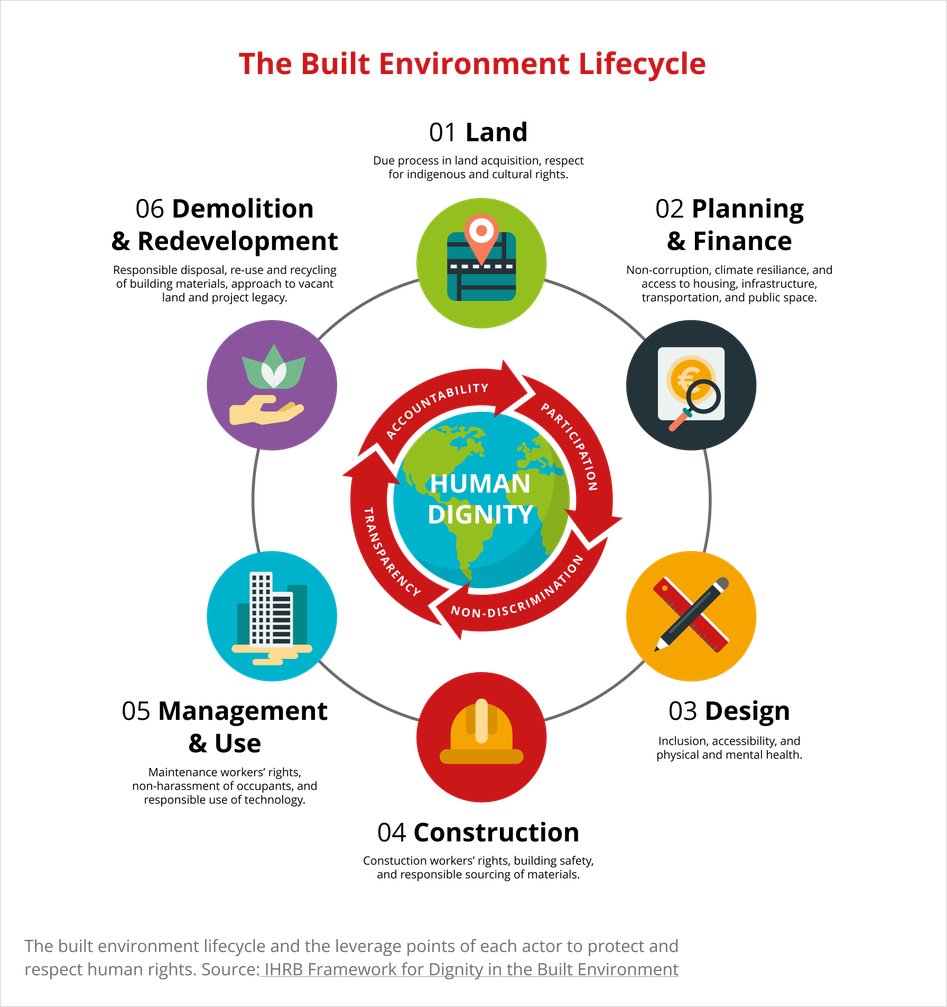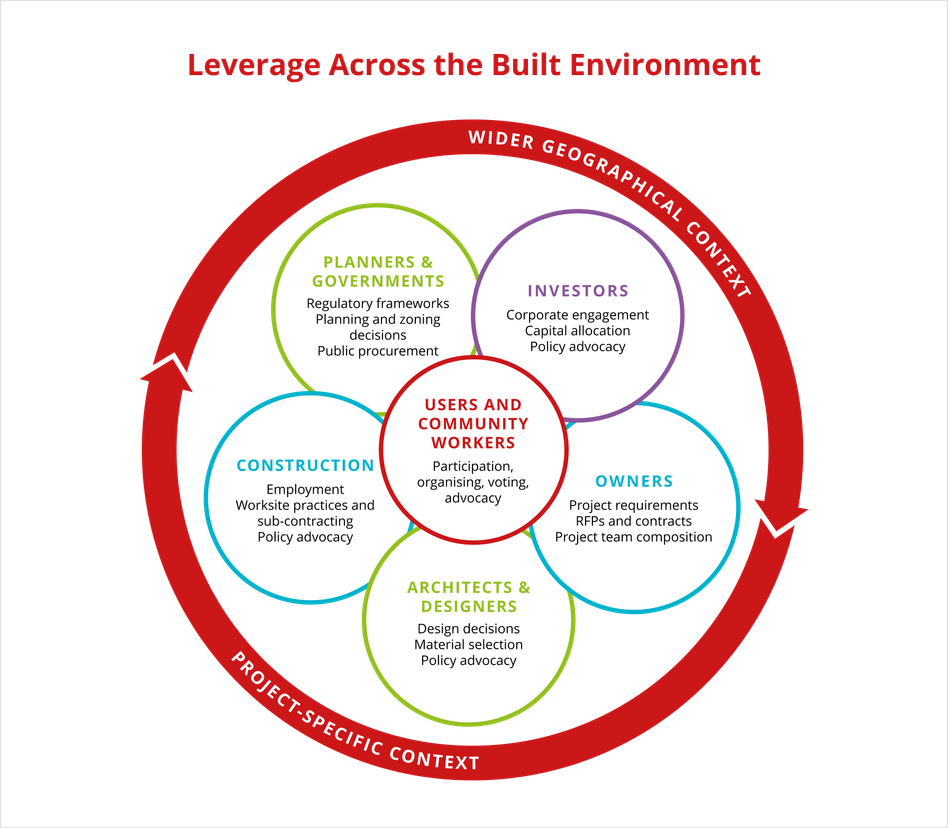Framework for dignity in the built environment
1 November 2020

The Framework for Dignity in the Built Environment guides decision-making throughout the built environment lifecycle: to manage risks to human rights and to maximise social outcomes.
As investment in infrastructure and urban areas seeks to respond to the climate crisis and stimulate economic recovery from the COVID-19 pandemic, integrating approaches that centre human dignity will be essential. This involves active participation by local communities, respecting the rights of workers, expanding access to adequate housing and services for all, and ensuring that all decisions are free from corruption.
The Framework aims to help:
- Communities shape decisions that impact their lives and neighbourhoods
- Governments establish the regulatory, planning and procurement context for just, thriving urban areas
- Investors manage social risks (the “S” in ESG), and channel investment into sustainable projects that meet locally-defined needs
- Architects and engineers respect dignity and human rights through their operations and supply chains.
Implementing the Framework
IHRB is working with partners in the Coalition for Dignity in the Built Environment and others to implement the Framework both at the level of policy interventions, and in the context of specific “Building Dignity Pilot Projects”.
We will also be developing a further tier of granular detail for the Framework, with examples of procurement provisions and measurable outcome metrics.

Overarching Framework
The Built Environment Lifecycle

Throughout all stages of the built environment lifecycle:
- All human rights standards are upheld, including the cross-cutting principles of transparency, accountability, participation and non-discrimination.
- Everyone has the opportunity to participate meaningfully in the decisions that affect their neighbourhoods and lives. This includes women, children, minorities, migrants, refugees, indigenous peoples, persons with disabilities, older persons and others whose perspectives are often excluded.
- Trade unions and civil society can operate freely.
- All decisions are free from corruption.
Land
- No-one is forcibly evicted from their home, in accordance with international standards.
- Land acquisition is carried out with meaningful consultation and following due process.
- Indigenous and cultural rights are protected.
Planning & Finance
- The right to adequate housing is respected – including security of tenure, affordability and habitability.
- All neighbourhoods have access to adequate infrastructure, public space, transportation, and employment opportunities.
- Systemic and past injustices are taken into account.
- Resilience to climate-related and other disasters is strengthened, with an emphasis on participation and social cohesion.
Design
- The built environment expands inclusion and accessibility, regardless of age, ability, race, gender and other factors.
- The built environment has a positive impact on physical and mental health.
- Design seeks to open rather than close space for the realisation of all human rights and the protection of human dignity.
- Materials are selected and sourced responsibly, with regard to their social and environmental impacts.
Construction
- Construction workers’ rights are respected in accordance with ILO standards, at all tiers of the construction process - by lead companies and sub-contractors.
- Buildings are structurally safe, putting an end to the preventable loss of life in building collapses and fires.
- See also: "Materials are selected and sourced responsibly, with regard to their social and environmental impacts" under DESIGN
Management & Use
- Everyone, including marginalised communities, has healthy, accessible, and safe, spaces to live, work, and be at leisure.
- Tenants and users are free from harassment.
- The rights of workers (employed directly and by subcontractors) - in the maintenance, servicing, cleaning and security of buildings - are respected.
- Technology is harnessed in a way that safeguards digital rights including privacy and freedom of expression.
- Transparent, accountable and reciprocal relationships are maintained with neighbouring communities.
Demolition & Redevelopment
- Vacant land is seen as an opportunity to realise communities’ needs, while land-use changes prioritise community consultation over financial speculation.
- Building materials are re-used and recycled responsibly.

Recommendations
Actors Driving Decisions Across the Built Environment

National Governments should:
- Commit and adhere to international human rights standards.
- Ensure co-ordination between agencies and regions for effective and equitable urban planning, disaster preparation and response.
- Enact human rights-based legislation conducive to responsible investment in the built environment.
- Require responsible conduct of nationally-headquartered companies operating overseas.
- Promote human rights in regional and international fora.
Regional and Municipal Governments should:
- Protect human rights through the adoption and enforcement of laws and policies, as well as measures to ensure accountability and transparency.
- Maximise residents’ participation in the decisions that affect their lives.
- Consider the full spectrum of rights and the full geographical context in planning and zoning decisions.
- Ensure that investment is channeled in the public interest.
Investors, Developers, and Owners should:
- Ensure responsible human rights-based investment that is closely aligned with locally-defined priorities and adds value to the communities where it is deployed.
- Shift investment away from an “extractive” approach that is focused narrowly on short-term profit-maximisation; proactively manage human rights risks at all relevant stages of the lifecycle, and engage investee companies on human rights risks and impacts.
- For project investments, adequately cost and plan the project to minimise the risk of rights abuses and of passing human rights risks down the supply chain.
Architects and Designers should:
- Design with the rights of vulnerable and marginalised groups and neighbouring areas in mind.
- Engage local communities in a meaningful way from the outset of any project and throughout its lifecycle.
- Take the human rights record of clients into account when deciding to accept a contract.
- Use any leverage over clients proactively to advance human rights.
- Support policy initiatives that strengthen dignity in the built environment.
Construction and Engineering Companies should:
- Ensure respect for all workers’ rights in direct operations and throughout the subcontracting chain.
- Ensure women have equal access to employment and training.
- Avoid corruption and conduct due diligence on all business partners.
- Source materials with consideration for their social and environmental impacts.
- Mitigate disruption to local communities during the construction process.
- Ensure that buildings are environmentally resilient and structurally safe.
Building maintenance and servicing companies should:
- Ensure that all workers’ rights are respected – including those employed by subcontractors – in the maintenance, servicing, cleaning and security of buildings.
- Respect the rights of those using and living in or near buildings.
Technology companies should:
- Respect digital rights, including the rights to privacy and freedom of expression.
- Seek to expand access to the benefits of technological innovation in urban areas.
- Ensure transparency, accountability and non-discrimination in the collection and use of data.

Resources
International Standards and Guidelines
The Framework draws on the following international standards and guidelines.
International human rights standards
- The full spectrum of United Nations standards on human rights: including the Universal Declaration of Human Rights, International Covenant on Civil and Political Rights, and International Covenant on Economic, Social and Cultural Rights
- International Labour Organization (ILO) conventions and standards. ILO fundamental conventions encompass freedom of association and the right to organise, forced and child labour, equal remuneration, and non-discrimination.
- The UN Guiding Principles on Business and Human Rights: Guiding Principles for the implementation of the “Protect, Respect and Remedy” framework on business and human rights
Human rights standards by issue
- Women: Convention on the Elimination of all Forms of Discrimination against Women (CEDAW)
- Children: Convention on the Rights of the Child
- People with Disabilities: Convention on the Rights of Persons with Disabilities
- Indigenous Peoples: UN Declaration on the Rights of Indigenous Peoples
- Migrant Workers: International Convention on the Protection of the Rights of All Migrant Workers and Members of Their Families
- Land: Office of the High Commissioner for Human Rights (OHCHR) resources on land as a cross-cutting issue that impacts directly on the enjoyment of a number of rights
- Forced Evictions: OHCHR resources on forced evictions
- Adequate Housing: OHCHR Right to Adequate Housing Toolkit
- Infrastructure: OHCHR resources on the right to water and sanitation
- Health: OHCHR resources on the right to physical and mental health
- Privacy: OHCHR resources on the right to privacy in the digital age
Global frameworks and guidelines
- UN Sustainable Development Goals
- New Urban Agenda
- OECD Guidelines for Multinational Enterprises
- UN Global Compact
- Sendai Framework for Disaster Risk Prevention
- International Guidelines on Urban and Territorial Planning (UN Habitat)
- UN Principles for Responsible Investment
- Equator Principles
- International Finance Corporation Performance Standards
- Global Reporting Initiative Standards
- Building Responsibly Worker Welfare Principles
- Dhaka Principles for Migration with Dignity (Institute for Human Rights and Business)
- Mega-Sporting Event Lifecycle (Institute for Human Rights and Business)
- Accord on Recommended International Standards of Professionalism in Architectural Practice (International Union of Architects)
- Children’s Rights and Business Principles (UNICEF, Save the Children, UN Global Compact)
Human Rights Cities
- Global Charter Agenda for Human Rights in the City
- European Charter for Human Rights in the City
- Gwangju Guiding Principles for a Human Rights City
Thematic city-level initiatives
- Cities for Housing / The Municipalist Declaration of Local Governments on the Right to Housing and the Right to the City
- Child-friendly cities (UNICEF)
- Global age-friendly cities (WHO)
- Safe Cities and Safe Public Places (UN Women)
- Cities Coalition for Digital Rights
Development of the Framework
The first tier of the Framework was launched in February 2020 following consultation with actors across the sector, offering a high-level vision for dignity at each stage of the lifecycle. Following further consultation on a second tier of detail, this expanded version includes guiding questions, references to international standards, and illustrative examples. The Framework is not a new set of standards. Rather, it is a catalyst for collaborative action and accountability linked to existing human rights standards and the Sustainable Development Goals.
We continually welcome feedback, including new examples of lessons-learned and of innovation to include and provide inspiration.
Get in touch with examples of action, or any questions about the Framework



